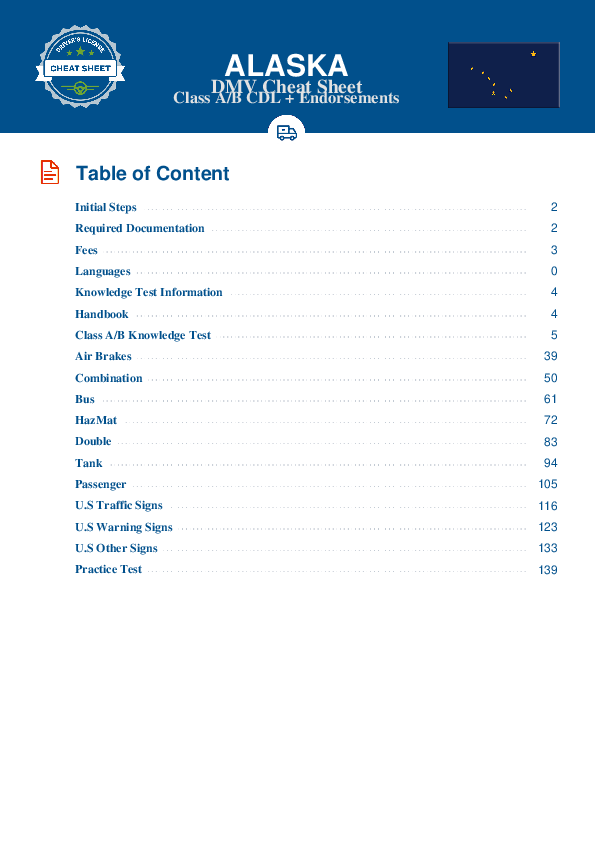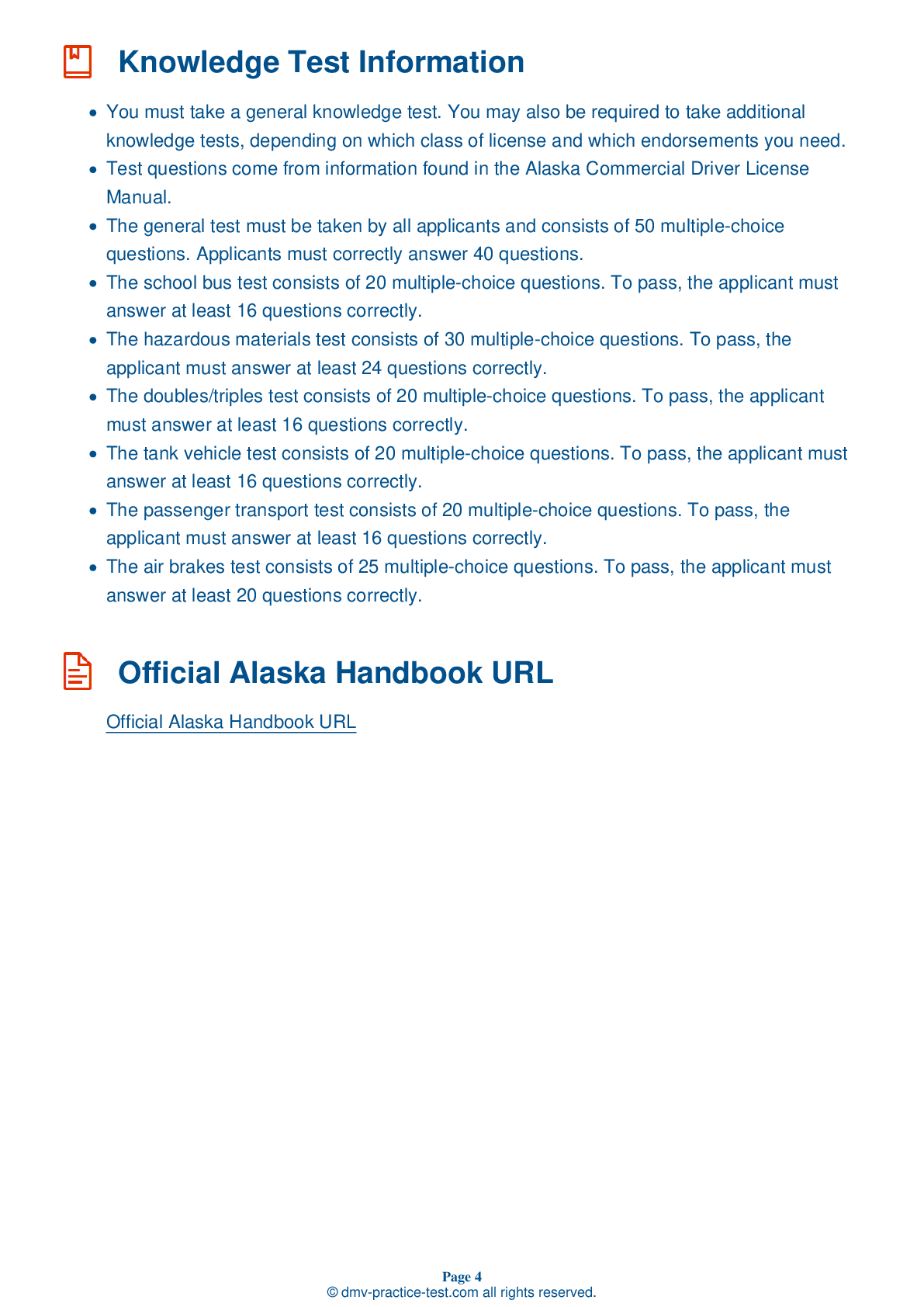Air Brakes #1
Air Brakes Endorsement Test | Alaska 2025 #1 Page 4 of 4
Train for FREE online with our Alaska CDL air brake test. The official exam test consists of several obligatory parts, with all of them checking your knowledge of different blocks of road rules. If you need to obtain a AK Class A/Class B driver license in 2025, practice as much as possible. Free sample tests published on our website will help you check and improve your knowledge and boost your grades. Please bear in mind that the requirements for CDL may vary from state to state.
25
20
20
19 . A low air pressure warning signal should activate:
When tank pressure falls below 5 psi.
In an air brake system, a low air pressure warning signal must come on if air pressure in the tanks falls below 55 psi. This warning signal may come in the form of a light, a buzzer, or a wig wag.
20 . What helps prevent wheel lockup when braking?
The purpose of an Anti-Lock Braking System (ABS) is to prevent wheel lockup while brakes are being applied.
21 . Anti-Lock Braking Systems (ABS):
If equipped, ABS is in addition to a vehicle's normal braking system and does not increase or decrease the braking power of any other system. ABS only activates when a vehicle's wheels are about to lock.
22 . What is often found in compressed air?
Compressed air in an air brake system usually contains a certain amount of water and compressor oil. The water and oil can damage the brakes if left to accumulate in the system. Tanks must be drained regularly to remove this build-up.
23 . A dual air brake system:
A dual air brake system is made up of two separate air brake systems. The systems share a single set of brake controls, but each has its own air tanks, hoses, and lines. One system typically operates the regular brakes on the rear axle or axles while the other system operates the regular brakes on the front axle.
24 . Friction in an S-cam brake is caused when the brake shoes and linings:
Friction inside a brake drum is caused when the brake shoes and linings push against the inside of the drum. The friction in the drums will slow and stop the vehicle.
25 . Some water and compressor oil is usually found in the compressed air within an air brake system. The water and compressor oil:
If water and compressor oil are left to build up in an air brake system, the system can be damaged. Air storage tanks are equipped with drains to allow this accumulation to be removed. Manually controlled drains should be operated at the end of each day of driving.
2025 Alaska | Frequently Asked Questions
To acquire a CDL Hazmat endorsement in Alaska, you must hold a valid Commercial Driver's License (CDL). Next, pass the Hazardous Materials Knowledge Test. You'll also need to undergo a TSA background check. Lastly, submit your application with the required fees at the DMV. Remember, endorsement renewal requires retesting and another background check.
Before obtaining a CDL Hazmat license, you must have a valid Commercial Driver's License (CDL). You also need to pass the Hazmat Endorsement Knowledge Test. Additionally, you must go through a Transportation Security Administration (TSA) security screening, which includes fingerprinting and a background check. You must also meet the federal qualification requirements.
To apply for a CDL Hazmat endorsement in Alaska, you need a valid Commercial Driver's License (CDL), proof of U.S. citizenship or legal status, a completed HAZMAT endorsement application, and a TSA security threat assessment clearance. You will also need to pass the Hazardous Materials Knowledge Test and a fingerprint-based background check.
Yes, there is a dedicated written test for the CDL Hazmat endorsement in Alaska. The Hazardous Materials Knowledge Test assesses your understanding of the rules and regulations related to transporting hazardous materials. You must pass this test to obtain the Hazmat endorsement on your Commercial Driver's License (CDL).
The CDL Hazmat endorsement written test covers a variety of subjects related to hazardous materials transport, including: understanding hazard classifications, how to safely load and unload hazardous materials, proper use of placards and labels, emergency response procedures, and understanding the risks associated with different types of hazardous materials.
Yes, acquiring a CDL Hazmat endorsement in Alaska involves additional charges. These include the cost for the written test, a background check fee, and the endorsement application fee. The exact amount may vary, so it's best to check with the Alaska Division of Motor Vehicles for current fees.
Yes, background checks are required for the CDL Hazmat endorsement. Applicants must undergo a federal security threat assessment conducted by the Transportation Security Administration (TSA). This involves fingerprinting and checking criminal, immigration, and terrorism records. The process ensures that hazardous materials are transported by trustworthy and reliable individuals.
Yes, specialized training is required for a CDL Hazmat endorsement. Applicants must pass a written Hazardous Materials Endorsement Knowledge Test. Additionally, they must complete a background check and fingerprinting process. These requirements ensure that drivers are adequately prepared to handle hazardous materials safely and responsibly on the road.
No, you cannot transport hazardous materials without a valid CDL Hazmat endorsement in Alaska. This endorsement is required by federal and state law for drivers transporting hazardous materials. Driving without the proper endorsement can result in serious penalties, including fines and potential disqualification from holding a commercial driver's license.
Yes, you can add the CDL Hazmat endorsement to your current CDL license. However, it requires passing a written knowledge test on hazardous materials. You also need to undergo a federal background check and fingerprinting. Once these processes are successfully completed, the Hazmat endorsement is added to your existing CDL license.



